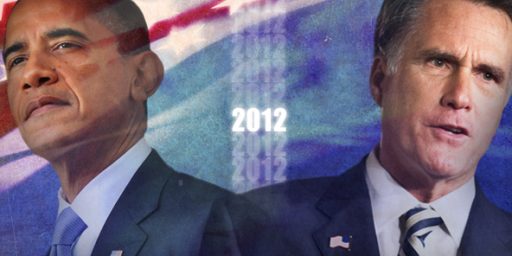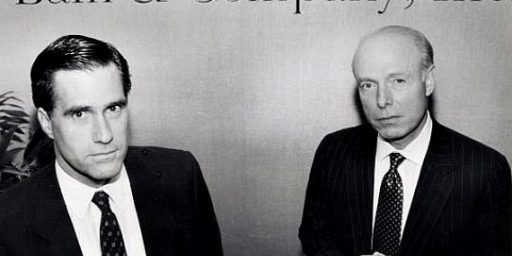Putting Probabilities in Perspective
Steven L. Taylor
·
Monday, October 29, 2012
·
19 comments
Jonathan V. Last:
People seem to think that it would reflect badly on Silver if Romney were to win while Silver’s model shows only a 25 percent chance of victory. But isn’t 25 percent kind of a lot? If I told you there was a 1-in-4 chance of you getting hit by a bus tomorrow, would you think that 25 percent seemed like a big number or a little number? Or, to put it another way, a .250 hitter gets on base once a game, so you’d never look at him in any given at bat and think there was no chance he’d get a hit.

About Steven L. Taylor
Steven L. Taylor is a Professor of Political Science and a College of Arts and Sciences Dean. His main areas of expertise include parties, elections, and the institutional design of democracies. His most recent book is the co-authored
A Different Democracy: American Government in a 31-Country Perspective. He earned his Ph.D. from the University of Texas and his BA from the University of California, Irvine. He has been blogging since 2003 (originally at the now defunct Poliblog).
Follow Steven on
Twitter






Here’s the thing: “people” don’t really think that. No one is really that stupid. People will say anything when they want to win, and they think spin, slander, and silliness will help them win.
The only reason the right is attacking Silver (besides the fact that the Republican Party is anti-science and math in general), is because his model runs counter to the “conventional wisdom” that Romney is surging and has momentum. The right is desperate to recreate 1980 when Reagan campaigned like he won already in the final weeks. leading to a landslide. Romney was hoping to do the same, with the help of the media, in order to squeak across the finish line, but Silver ruined it by showing that he is more of a prohibitive underdog and not even close to being the favorite. It’s a common Republican strategy to attack those that they disagree with as illegitimate. I fully expect them to go after Sam Wang at the Princeton Consortium next time, since he is starting to get noticed for his election model, also.
The real question is whether Mr. Silver is doing Monte Carlo modeling with sensitivity analsyis. Then we could be discussing how his model works and the part of the model that is most sensitive to errors.
I think people just can’t wrap their heads around how the polls can simultaneously be tied and yet Obama has a 75 percent chance of winning. Partly, because people don’t understand complex statistics. Partly, because, even after 2000, they still don’t really understand the Electoral College. Plus, I hear Nate Silver is less than burly and might even be one of them homosexuals.
@James Joyner: It is a perplexing and confusing world, to be sure.
And indeed: “even after 2000, they still don’t really understand the Electoral College.”
That’s where I think Wang at Princeton Polling setting the probability at 90-97%, who is using similar methodology, is missing something that Silver is wisely factoring in.
The people are being subjected to intense psy-op campaigns, the efficacy of which are impossible to predict.
Whatever character defects I exacerbated by years of playing Dungeon & Dragons, I did at least acquire a practical intuition for simple probabilities. If you roll percentage dice 100 times in an evening, lo! you will likely roll 100 at least once. Etc.
Republicans and media pundits are mad because Silver is destroying their narrative of a Romney surge, and therefore a 50/50 race.
The funny thing is that Nate is a bit late to the ball game, Sam Wang has been saying for a while now that the race is fairly static and that Obama has small but consistent lead.
@Anderson:
You roll two ten-sided dice (or one 100 sided die) once, then the probability of not getting a 100 is 99/100 or 0.99.
If you roll the two dice twice, then the probability of not getting a 100 is 0.99*0.99.
If you roll the two dice 100 times, then the probability of not getting a 100 is 0.99^100, or about 0.366.
Thus, the probability of rolling a 100 if you roll the two dice is 1-0.99^100, or about 0.634.
@PJ:
Should have been:
Almost 2 out 3 times, nowhere near every time, and definitely not at least once (that’s impossible, since then every outcome, 1-100, should also come up at least once…)
Obviously, the dice need to be fair.
Republicans don’t reckon for that math and science stuff, especially when done by one of those skinny Jewish homosexuals.
@superdestroyer:
While I took a couple statistics classes in college, I don’t know exactly what Silver is doing. But, what you speak of may have something to do with the difference between his “forecast” and what he calls his “now-cast”.
Same goes for Jonathan V. Last’s example:
If the .250 hitter bats four times in a game and the probability of him hitting the ball and getting on base at any at-bat is .250 and we disregard any other way for him to get on base, then the probability of him getting on base is 1-(1-0.250)^4, or 0.684.
(Only reason why I bring this one up too, is so that I can point out that the Giants won the World Series. For the second time in three years. And they swept the Tigers.)
@PJ: Yes, he confuses on-base percentage and batting average.
@Anderson:
Rolling a six sided die three times gives you less than a 50% change of rolling any particular number. It is one of the basic lessons in statistics.
@Steven L. Taylor:
Don’t think he does, seems more like he is a bit unsure about probability.
(Barry Bonds had an OBP of 0.609 in 2004, which means that, if we disregard any other factors like pitchers etc and give him a probability 0.609 to reach base at any at-bat, and he has four at-bats, there’s a 0.977 probability that he reaches in a game. One may wonder what his OBP had been if he hadn’t been intentionally walked 120 times that year.)
One may wonder what his OBP had been if he hadn’t been
intentionally walked 120 timesjuicing that year.)FTFY
Having clicked through the link I have two questions:
– Who the heck is Jonathan V. Last?
– Given Mr. Last’s apparent lack of even a rudimentary understanding of probability, why should I care about his opinion of Nate Silver’s analysis?
@OzarkHillbilly:
I knew someone would make that comment 🙂
I have yet to find something showing that steroids improve reaction time or pitch recognition. Using steroids will, if you’re actually able to connect in the first place, give you extra power to hit home runs, which, since it’s a hit, will help raise your OBP, but then it will also mean that you may get intentionally walked more, which then will lower your OBP. Bonds hit 45 home runs in 2004, but got intentionally walked 120 times. The latter hurt his OBP a lot more than the former.
(Personally, I’m all for a lot more tests and harsher penalties.)